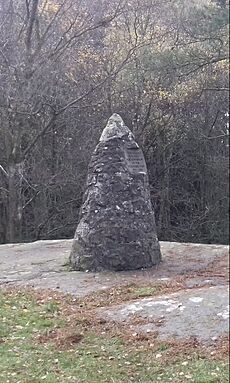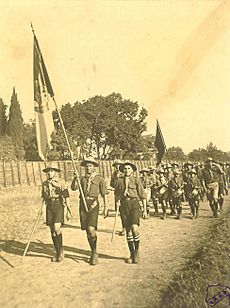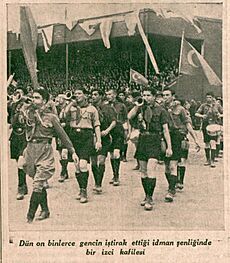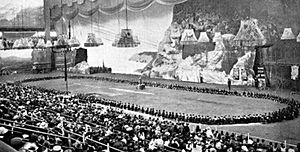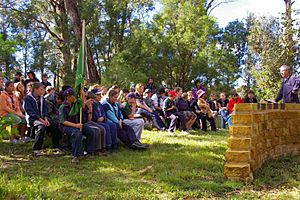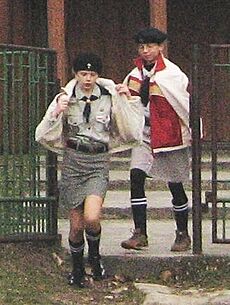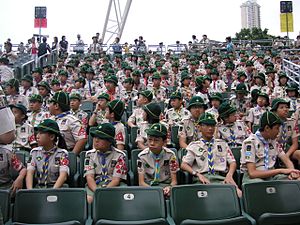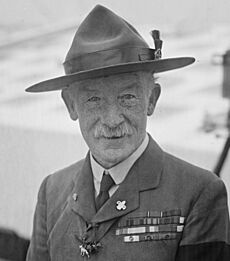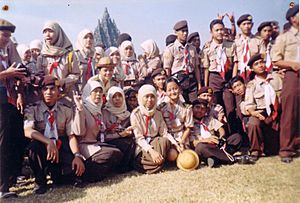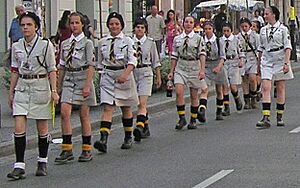Scouting facts for kids
Quick facts for kids Scout Movement |
|||
|---|---|---|---|

Scouts and Guides from several different countries meet at a World Scout Moot in Sweden, 1996
|
|||
| Founded | 1907 | ||
| Founder | Robert Baden-Powell | ||
|
|
|||
Scouting is a worldwide youth movement that started in the early 1900s. It teaches young people important life skills through fun outdoor activities. These activities include camping, learning about woodcraft, aquatics (water activities), hiking, and sports.
A well-known part of Scouting is the Scout uniform. It helps everyone feel equal, no matter their background. The uniform often includes a neckerchief (also called a scarf) and a special hat. Scouts also have unique badges, like the fleur-de-lis and merit badges. For girls, many organizations are called Girl Guides and use a trefoil symbol instead of the fleur-de-lis.
Scouting programs are designed for different age groups. The first program was for young people aged 11 to 17. Later, programs like Wolf Cubs and Brownies were created for younger kids. There are also programs for older members, such as Rovers and Rangers. Some groups even focus on special interests, like Sea Scouts for water activities.
In 2019, there were over 55 million Scouts and Guides in at least 155 countries! Scouting is not just one big organization. Instead, there are many local, national, and international Scout groups. The two largest international groups are the World Organization of the Scout Movement (WOSM) and the World Association of Girl Guides and Girl Scouts (WAGGGS).
Contents
How Scouting Began
The Start of a Great Idea
In the late 1800s and early 1900s, people were very interested in stories about brave frontier and military scouts. Boys and girls loved reading about them and even tried to act like them. Some teachers and youth leaders started teaching kids "scoutcraft," which included skills like tracking and survival.
Robert Baden-Powell, a British army officer, wrote books about military scout training. His book Aids to Scouting became very popular, especially after he became famous during the Second Boer War.
Inspired by the interest in his books, Baden-Powell decided to write a book just for boys. He also learned from Ernest Thompson Seton, a naturalist who had ideas about training young people in nature skills.
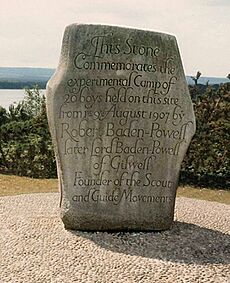
In August 1907, Baden-Powell held a special week-long camp on Brownsea Island in England. He wanted to test his ideas with 21 boys from different backgrounds. The boys worked in small groups, each with a chosen leader. This camp was a big success and helped promote his new book.
Scouting for Boys and Its Impact
In 1908, Baden-Powell's book, Scouting for Boys, was published. It taught outdoor skills and new ways to learn, focusing on building good character, citizenship, and physical fitness. The book was a huge hit and is now one of the best-selling books of all time!
Because of the book's popularity, boys (and even some girls) started forming their own Scout groups, even without an official organization. In 1909, a big Scout Rally was held in London, with 11,000 Boy Scouts and some Girl Scouts attending.
Soon, local and national Scout organizations were formed. In 1910, Baden-Powell created The Boy Scouts Association in the UK.
Girl Guides: A Separate Path
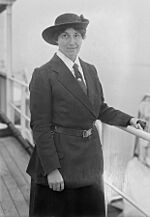
Many girls wanted to be part of the Scout Movement from the very beginning. However, at that time, it was not common for boys and girls to "rough and tumble" together in the same groups. So, in 1910, Baden-Powell, with help from his sister Agnes Baden-Powell, started a separate organization for girls called the Girl Guides Association. Other countries soon followed.
By the 1990s, many Scout organizations around the world started allowing both boys and girls to join the same groups.
The First Scout Law and Promise
The first Scout Law was a set of rules for boys to live by. It taught them to be trustworthy, loyal, helpful, friendly, courteous, kind to animals, obedient, cheerful, thrifty, and clean in thought, word, and deed.
The Scout Promise was an oath boys took to become a Scout. It said: "On my honour I promise that—
- I will do my duty to God and the King.
- I will do my best to help others, whatever it costs me.
- I know the scout law, and will obey it."
When taking this oath, Scouts would hold up their right hand in a special salute.
Scouting Spreads Across the Globe
The Scout Movement quickly grew throughout the British Empire. By 1908, Scouting was in places like Gibraltar, Malta, Canada, Australia, New Zealand, and South Africa. Chile was likely the first country outside the British Empire to have a national Scout organization in 1909. By 1910, Scouting had reached many other countries, including Argentina, Denmark, France, Germany, India, Mexico, the Netherlands, Norway, Russia, Sweden, and the United States.
Programs for All Ages
As Scouting grew, programs were developed for younger children who were too young to be full Scouts. In 1916, the Boy Scouts Association started Wolf Cubs. In the United States, Cub programs began around 1911.
Programs for older members were also created. In 1918, the Boy Scouts Association formed Rovers for young men who wanted to stay involved after being Scouts.
Training for Leaders
To help adult leaders guide the young Scouts, training camps were set up. In 1919, Gilwell Park in England became a special training site. Here, leaders could earn their Wood Badge, a special award for completing advanced training. Baden-Powell also wrote Aids to Scoutmastership to help leaders.
How Scouting Influenced Society
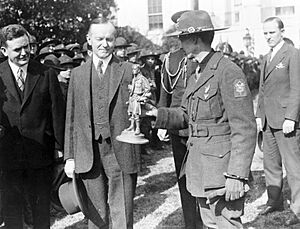
Scouting's ideas came from Baden-Powell's experiences in the military and his love for the outdoors. He was a retired general when he wrote Scouting for Boys. His book inspired thousands of young people to try new activities.
Baden-Powell learned a lot about outdoor skills from Frederick Russell Burnham, an American scout he met in Africa. These skills, like tracking and self-reliance, became the basis of "scoutcraft." During a siege in South Africa, a group of young people called the Mafeking Cadet Corps helped by carrying messages. This also inspired Baden-Powell to write his book.
When he returned to England, Baden-Powell saw that his military training book was being used by youth groups. He decided to rewrite it for boys, creating the Scouting movement we know today.
Scouting has been adopted by many different cultures. For example, Scouts in the United States use ideas from the American frontier and Native American traditions. British Scouting uses images from its history in places like Canada, India, and Africa.
"Duty to God" is an important principle in Scouting, but it means different things in different countries. Some organizations are very strict about it, while others allow more flexibility for different beliefs. For example, in the UK, Scouts can choose to promise to "uphold our Scout values" instead of "duty to God."
What Makes Scouting Special?
Scouts use the "Scout method," which is a way of learning through hands-on outdoor activities. Programs are available for young people from about 6 to 25 years old, with activities suited for each age.
The Scout Method: Learning by Doing
The Scout method is how Scout groups work. It's a voluntary, non-political educational movement for young people, open to everyone regardless of their background or beliefs. The main goal of Scouting is to help young people grow into their full potential physically, mentally, socially, and spiritually. It also helps them become responsible citizens.
The Scout method has seven key parts:
- The law and promise (the values Scouts live by).
- Learning by doing (hands-on experiences).
- The team system (working in small groups).
- A symbolic framework (using symbols and stories).
- Personal progression (growing and learning new skills).
- Nature (connecting with the outdoors).
- Adult support (guidance from leaders).
The Scout Law and Promise are the core values that unite all Scouts. "Learning by doing" helps Scouts gain confidence. Working in small groups builds friendship and teamwork. These experiences, along with honesty and honor, help Scouts become responsible, self-reliant, and ready for challenges. Fun activities and games help Scouts develop skills and connect with nature.
The Scout Motto, "Be Prepared," has been used by millions of Scouts since 1907. Another well-known saying is the Scout Slogan, "Do a good turn daily."
Fun Activities in Scouting
Scouts often meet in small groups, sharing experiences and activities. They learn about good citizenship and make decisions together. A big part of Scouting is loving and appreciating the outdoors. Main activities include camping, woodcraft, water sports, hiking, and other sports.
Camping trips are common, often with just one Scout troop. There are also larger camps called "camporees" or "jamborees." Camporees are usually weekend events with several groups from a local area. Jamborees are huge national or international events held every four years, where thousands of Scouts camp together for one or two weeks. These events include games, skill competitions, and badge trading.
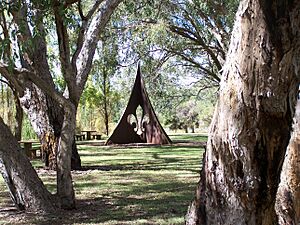
For many Scouts, a highlight of the year is a summer outdoor activity, like a week-long camping, hiking, or sailing trip. At summer camps, Scouts can work on badges and improve their skills. Some camps offer special programs for older Scouts, such as canoeing or caving.
Scouting also promotes peace and understanding between different countries. They work with other groups, including the United Nations, to help communities and encourage tolerance.
Uniforms and Special Badges
The Scout uniform is a very recognizable part of Scouting. Baden-Powell said the uniform "hides all differences of social standing... and makes for equality." It also helps Scouts from different countries feel like they are part of one big family. The first uniform was a khaki shirt, shorts, and a wide-brimmed hat. Today, uniform shirts can be blue, orange, red, or green, and long trousers are often worn.
The uniform is not just for looking smart; it's also practical. For example, neckerchiefs can be used as slings or bandages in an emergency.
Special badges worn by Scouts worldwide include the Wood Badge and the World Membership Badge. Scouts use a fleur-de-lis symbol, while Girl Guides use a trefoil.
Scouting for Different Ages
Many Scout and Guide organizations have programs for different age groups. These groups have changed over time to fit local cultures.
Scouts are typically young people between 11 and 17 years old. Most Scout organizations have groups like Boy Scouts, Girl Scouts, or Guides for this age. For younger children, there are programs like Cubs (ages 6 to 10) and Brownies. Some organizations also divide Scouts into "junior" and "senior" groups.
Here are some traditional age groups from the past:
| Age range | Boys section | Girls section |
|---|---|---|
| 8 to 10 | Wolf Cubs | Brownie Guide |
| 11 to 17 | Boy Scout | Girl Guide or Girl Scout |
| 18 and up | Rover Scout | Ranger Guide |
Today, programs for younger children include Lions, Tigers, Wolfs, Bears, Webelos, Arrow of the Light Scouts, Cubs, Brownies, Daisies, Rainbow Guides, Beavers, Joeys, Keas, and Teddies. For older teens and young adults, there are programs like Rovers, Rangers and Young Leaders, Senior Scouts, Venturer Scouts, Explorer Scouts, and the Scout Network. There are also special programs for those with special needs, often called Extension Scouting.
Adults and Leaders in Scouting
Adults who support Scouting, including former Scouts and Guides, can join groups like the International Scout and Guide Fellowship. In the United States, university students might join the service fraternity Alpha Phi Omega.
Scout groups are usually run by adult volunteers. These can be parents, former Scouts, students, teachers, or religious leaders. Some leaders wear uniforms and have special training, like the Wood Badge. Other adults help out in different ways, like on committees.
Each Scout group has uniformed leaders, such as the Scoutmaster and their assistants. There are also leaders at higher levels, like district or county Commissioners, who work with teams of volunteers and paid staff. In the UK, the national Scout organization appoints a Chief Scout, who is the most senior uniformed member.
Scouting Around the World
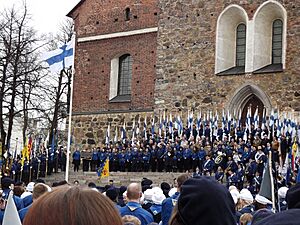
After starting in the United Kingdom, the Scout Movement quickly spread worldwide. Chile was one of the first countries outside the British Empire to form a national Scout organization in 1909. Today, most countries have at least one Scout organization.
International Scout organizations were also formed. In 1911, the World Scouts was created. In 1922, the World Organization of the Scout Movement (WOSM) was formed, which organizes the World Scout Jamboree every four years. In 1928, the World Association of Girl Guides and Girl Scouts (WAGGGS) was created for girl-only organizations. WAGGGS runs four international centers: Our Cabaña in Mexico, Our Chalet in Switzerland, Pax Lodge in the United Kingdom, and Sangam in India.
Boys and Girls in Scouting
Scouting has taken different approaches to including both boys and girls. Some countries have separate organizations for boys and girls. In other countries, especially in Europe, Scout and Guide organizations have merged into one group for both. The Boy Scouts of America started allowing girls to join their Cub Scout and Boy Scout programs in early 2018.
In countries like Australia and the United Kingdom, the national Scout association includes both boys and girls and is a member of WOSM. However, their national Guide association remains separate and is a member of WAGGGS. In some countries, like Greece, there are separate Scout and Guide associations, but both allow boys and girls to join.
The Scout Association in the United Kingdom has included both boys and girls at all levels since 1991. By January 2007, all Scout groups in the UK were required to be co-educational.
How Many Scouts Are There?
As of 2019, there are over 46 million registered Scouts, and as of 2020, there are 9 million registered Guides around the world. They come from 216 countries and territories.
| Country | Membership | Population participation |
Scouting introduced |
Guiding introduced |
|---|---|---|---|---|
| Indonesia | 24,760,000 | 9.2% | 1912 | 1912 |
| India | 5,930,000 | 0.4% | 1909 | 1911 |
| United States | 4,910,000 | 1.8% | 1910 | 1912 |
| Philippines | 3,340,000 | 3.2% | 1910 | 1918 |
| Kenya | 2,400,000 | 4.2% | 1910 | 1920 |
| Bangladesh | 2,090,000 | 1.3% | 1914 | 1928 |
| United Kingdom | 940,000 | 1.8% | 1907 | 1909 |
| Nigeria | 870,000 | 0.4% | 1915 | 1919 |
| Pakistan | 830,000 | 0.4% | 1909 | 1911 |
| Thailand | 810,000 | 1.2% | 1911 | 1957 |
| Tanzania | 630,000 | 1.0% | 1917 | 1928 |
| Uganda | 570,000 | 1.3% | 1915 | 1914 |
| Malawi | 430,000 | 2.2% | 1931 | 1924 |
| Malaysia | 400,000 | 1.2% | 1908 | 1916 |
| Turkey | 290,000 | 0.4% | 1909 | |
| Germany | 250,000 | 0.3% | 1910 | 1912 |
| Italy | 230,000 | 0.4% | 1910 | 1912 |
| Canada | 220,000 | 0.5% | 1908 | 1910 |
| France | 210,000 | 0.3% | 1910 | 1911 |
| Belgium | 170,000 | 1.5% | 1911 | 1915 |
Other Scout-like Groups
Besides the main Scout organizations, many other groups have formed over time. Some were created for specific religious, gender, or language groups. Others wanted to go back to older, more "traditional" Scouting methods.
In 2008, there were at least 539 independent Scout organizations worldwide. About 90 of these groups have created their own international organizations, such as:
- Order of World Scouts, founded in 1911.
- International Union of Guides and Scouts of Europe, a faith-based group started in 1956.
- Confederation of European Scouts, created in 1978.
- World Federation of Independent Scouts, formed in Germany in 1996.
Some other youth groups are similar to Scouting, often with religious connections, for example:
- Pathfinders – a youth group of the Seventh-day Adventist Church, formed in 1950.
- Royal Rangers – a youth group of the Assemblies of God, formed in 1962.
Scouting in Movies and Art
The Scout Movement has appeared in many movies and artworks over the years. For example, in the movie Indiana Jones and the Last Crusade, the young Indiana Jones is shown as a Boy Scout.
Artists like Norman Rockwell and Joseph Csatari have created famous paintings of Scouts. Movies like Follow Me, Boys! (1966) show the spirit of Scouting. Sometimes, Scouts are shown in a funny way, like in the films Troop Beverly Hills (1989) and Down and Derby (2005). The Scottish singer Gerry Rafferty even recorded a song called I was a Boy Scout in 1980.
See also
 In Spanish: Escultismo para niños
In Spanish: Escultismo para niños
- Pioneer movement
- Lookwide Camp


